Covid in Austria: 2.6m Remain 'Unvaxxed', and Reinfections Are On The Rise, 96.8% of Which Occurred Since 1/1/2022
About 8% of Austrians who already had Covid-19 were reinfected at least 1X, the overwhelming majority contracted the disease again since 1 Jan. 2022
Welcome, dear readers, to a slightly modified ‘update’ on (most) matters Covid-19 in the area that once used to be my country of origin. Over here, I’ve been mostly writing about the social and political sea change that arrived on the coasts of Central Europe in the guise of ‘infection control measures’, and if you’re interested in my writings, I invite you to my essays entitled ‘Covidistan Annals’.
Covering roughly the period from late October 2021 to Easter 2022, I tried to trace Austria’s transformation into a kind of biosecurity-obsesses mental institution. For starters, you might with to begin with my three-part introduction to Austria/Covidistan, written in late November and early December 2021 (part 1, part 2, and part 3).
I shall continue to report on these political issues every now and then, as time and opportunities to highlight certain facets suggest; in this slightly modified category, entitled ‘Covid in Austria’, I shall bring you infrequent updates on the inanities of the domestic politicians and their lackeys in corporate media that are, I’d argue, of a more general importance.
Actually Useful Data—from Statistik Austria
In my most recent pre-Easter posting, I mentioned that Statistik Austria, the government’s official number-crunchers, actually posted some useful data over at their website. They did so at the request (order) of the Health Ministry, which prompted a kind of flurry of news items, which we shall quickly go through now.
On Good Friday, state broadcaster ORF kicked off the festivities by calling out the fact that ‘1.3m [Austrians] remain neither vaccinated nor recovered’:
52.3% of Austrian residents held a valid vaccination certificate at the end of March without having been infected with the coronavirus. Another 17.2% had been vaccinated but had also become infected with Sars-CoV-2 [i.e., ‘breakthrough infections’].
The vaccination rate stood at 69.5% [of those 18 and older]. On the other hand, 15.7% had not been vaccinated and 14.7%, or about 1.32m people, had neither been vaccinated nor recovered, according to Statistik Austria (my emphases).
This is good news in terms of the roughly 30% of residents who didn’t receive any of these experimental injections. It is also an admission of guilt on part of the authorities with respect to the incredible amounts of gaslighting in terms of incessant characterisations of these products—remember how ‘safe & effective’ these are or their incredible powers to prevent transmission?
Here’s the breakdown of the current numbers, courtesy of the Health Ministry (as of 14 April 2022):
Note, in particular, that the population’s willingness to receive ‘more’ of these products dropped by almost 30% (if you juxtapose 1st dose vs. 3rd dose uptake).
Back to ORF for a moment, which ‘explains’ these data with respect to children in what I consider perhaps the most insane way (my emphases):
Among children, who were vaccinated against Sars-CoV-2 much later than adults, the share of those who have recovered is comparatively high. Omicron has ‘affected’ a considerable proportion of children. At the end of March, 21% of kids aged 5-9 had already been vaccinated, but another 40% of this age group held only [sic] a certificate of recovery.
The share of those exclusively recovered was just as high among kids aged 10-14, but among them, some 41% had a valid vaccination certificate. Among adolescents and adults aged 15 and older, between 89-92 per cent had a valid vaccination and/or recovery certificate.
Just a couple of brief comments here before we move on. This is unambiguously good news, as these ‘unvaccinated’ children may now build up natural immunity, which is arguably the best kind thereof. Conversely, the 89-92% injection uptake indicates both insanely high rates of compliance—as well as highlights the following fact: those roughly 2.6m people who remain neither ‘vaccinated’ nor ‘unrecovered’ are simply ‘too many’ to force-inject.
Note, further, that these are either minors (for whom somebody else bears responsibility as they are not legally of age) or those who are too ill, frail, and weak to receive such a dangerous injection in the first place.
Reinfections in Austria
Speaking of consequences, these data also indicate a quite marked increase in re-infections, as we learn last week from a piece from the reliable Covid hawks over at Der Standard. Compiled by renowned nonsense-pusher Magdalena Pötsch, the article provides a lot of actually useful information as well.
Of the around four million infections registered so far, 322,607 were second infections and 7,402 were third infections. This means that almost 8% of all people who have recovered from Covid-19 have already had two infections, and 0.18% have contracted Covid-19 even three times—and the trend is still rising.
But, wait, there’s another admission that—to me, at least (and perhaps Igor Chudov will agree, too)—constitutes a veritable ‘bombshell’:
The fact that more and more people are becoming reinfected is mainly due to the different variants, which repeatedly evade immune protection against infection better than their predecessors… simulation researcher Niki Popper: ‘You can clearly see that the numbers of two and multiple infections caused by Omicron are increasing.’ Before Omicron, there were hardly any reinfections; just under 97 percent of all reinfections were reported in 2022. (emphases mine)
Note that Ms. Pötsch also relates these numbers to a recent survey by the British ONS from June 2021 (see here), which I omitted because the study period covers ‘only’ the pre-Delta era.
There’s more in this Standard piece:
This development has to do with what is called cross-immunity, explains virologist Christoph Steininger from the Medical University in Vienna: ‘The more closely two virus variants are related to each other, the more likely we are to be protected. The difference between Omicron and Delta is so great that a Delta infection does not protect very well against an Omicron infection.’
Here, too, we can observe the by-now typical (normalised) myopia: for those ‘vaccinated’ with these experimental genetic injections designed against the wild type is—knowingly?—omitted.
In the long run, experts agree that everyone will be infected with Corona several times. The number of reinfections will continue to rise. This phenomenon is known from other infectious diseases, says Steininger: ‘Think of the common cold. There are more than 100 subtypes of rhinoviruses. Everyone has had a cold at one time or another, but we still get one every now and then.’ However, this does not mean that a Covid-19 infection can be compared to the common cold, he emphasises: ‘Corona is a serious infectious disease. The common cold is also milder because we already have broad immunity here.’
I’d also argue that the common cold is also ‘milder’ because humans have been exposed to these hundreds of rhinoviruses since, well, time immemorial. If Sars-Cov-2 evolves along these lines, maybe it will become ‘just another cold’ at some point in time.
Dr. Steininger was supported in this claim by notorious mandate hawk Dorothea von Laer (virology, U Innsbruck) who is quoted, however incoherently, as follows:
‘The probability of being reinfected with BA.2 again after Omicron BA.2 is less than 1%.’
On the other hand, those who were infected with Delta or an earlier variant and are not additionally vaccinated are only about 50% protected against reinfection with Omicron [no data provided]. Those with hybrid immunity…have the lowest risk of reinfection with Omicron, explains [von Laer]: ‘They have so many antibodies that they are also very well protected against BA.1 and BA.2.’
This can be assumed at least on the basis of antibody data, yet reinfection data hardly exist: ‘Based on antibody figures, one must further deduce that the Omicron variants BA.1 and BA.2 only protect against each other to a limited extent. There is some cross-immunity, but the probability of reinfection is relatively high’, says von Laer.
Things we learn from ‘the experts’: reinfections are very much improbable, but we don’t really have data to calculate this. As to ‘hybrid immunity’, well, what can I say? Antibody levels wane over time, which is ‘natural’ (dare I say that?) as these are a function of your body fighting off an infection; once the infection is under control, why keep antibody levels high?
Yet, what I’d really *love* to know, Dr. von Laer, is this: you speak of a ‘relatively high probability of reinfection’—would that include antigenic priming via the currently available EUA-only injectable products?
Ms. Pötsch concludes her piece on the following note:
The more often one is exposed to the virus, the broader one’s immunity becomes. Nevertheless, one should continue to protect oneself as best as possible—especially through vaccination, appeals Steininger: ‘An infection still offers the risk of a severe course.’ In the future, however, the courses of Covid-19 will become increasingly mild, he predicts, ‘because the population will have more and more basic immunity’.
See, if you ever wondered if one can make an omelette without breaking eggs, there you go.
The Standard piece comes with the following illustration, with my emphases added:
Reinfections in Austria
Of the total number of 4,042,084 infections since March 2020, 2,763,568, or 68.4%, of all infections occurred since 1 January 2022.
Of the total number of 322,607 reinfections (2x, of which 7,402 were 3x), 319,356, or 96.8%, of reinfections occurred since 1 January 2022.
Given the above data, it is imperative to note the most obvious conclusions:
Reinfections are a real thing, and I’d add that we desperately need to know whether these reinfections occur—partially, mainly, overwhelmingly, or exclusively—among the ‘vaccinated’ and/or ‘boosted’ population.
If anecdata is any guide, I’ll invite you all to go through the Standard ‘dedicated thread’ on this. Entitled ‘did you get infected with Covid-19 more than once’, the notoriously hawkish paper invited reader comments on this crucial issue. The piece went live on 14 April 2022 at 9 a.m. (local time), and by the time I write these lines, there are 219 postings:
Here’s a quite representative example:
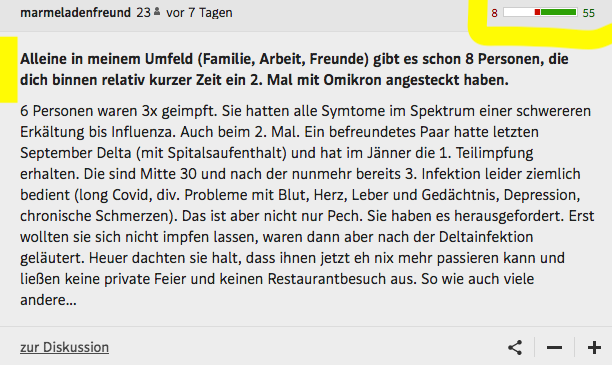
Here’s an anecdotal poll from this page (note that I added my ‘vote’ to be able to see the results; I clicked ‘once’, or einmal):
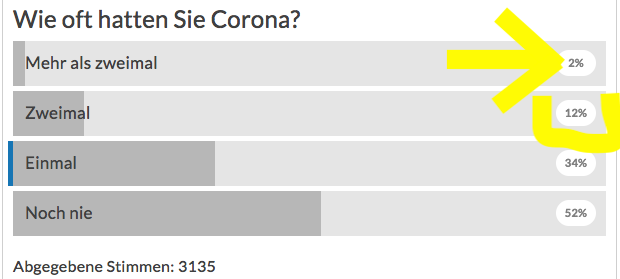
I briefly went through the 219 postings, here are some of the highlights:

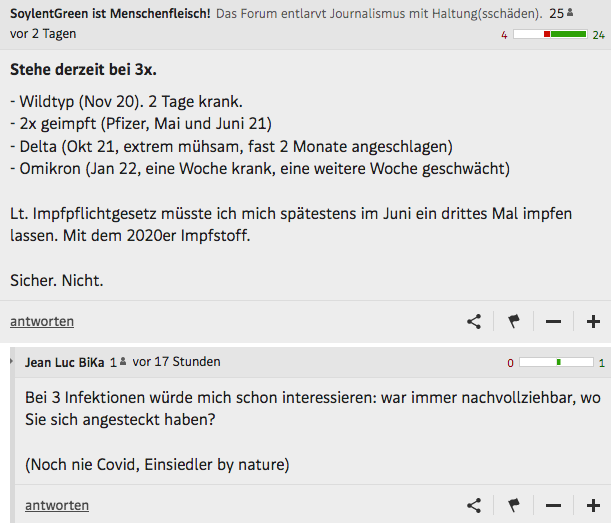
In my last dedicated post, we briefly touched on the VE issue by pointing to the below-reproduced table from Statistik Austria:
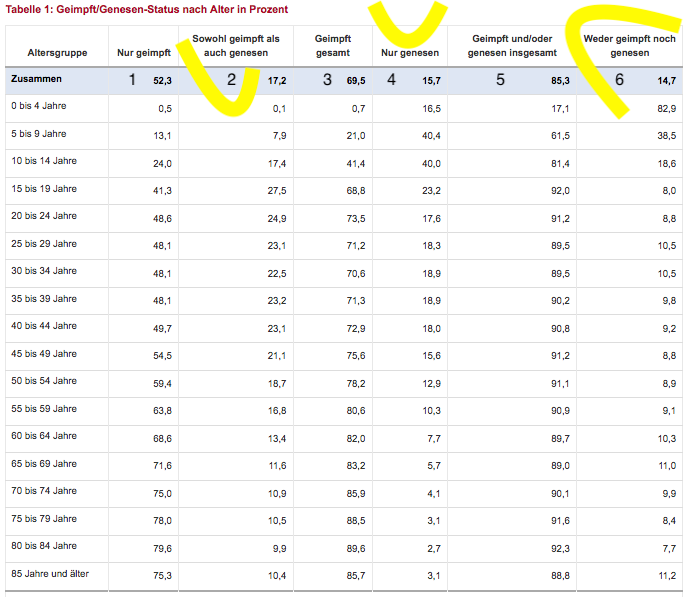
Summary and Commentary
Given the above information, here’s what I think we *must* learn: add data about the ‘booster’ injection dates to learn about the possible temporal association of their administration and reinfections. As per OWID:
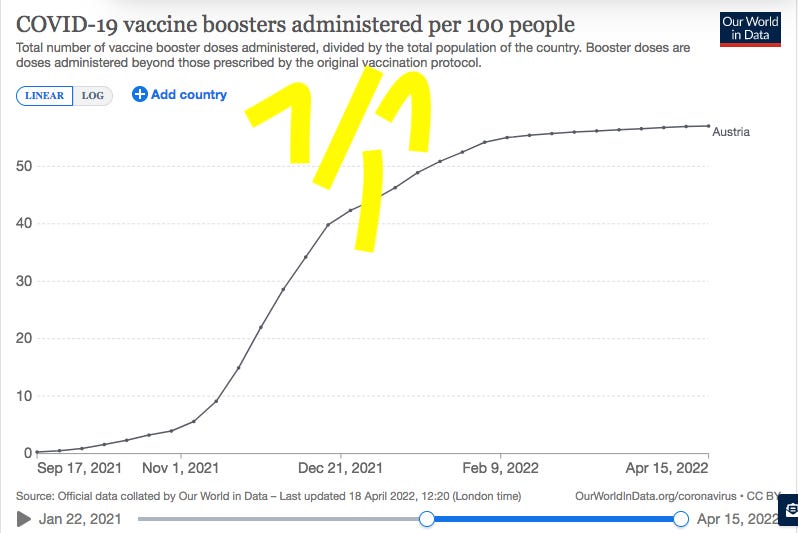
I have this strong suspicion—as in: mathematical probability—that the overwhelming number of these 322,607 reinfections occurred in a population that is 89-92% ‘vaccinated’ (aged 15 and older).
I further suspect that many of these ‘breakthrough’ infections (see Table 1, above) occurred in the ‘fully vaccinated’ and/or ‘recently boosted’ cohorts (these would include my ±70yo parents, both of whom took a ‘booster’ in early December and came down with Covid-19 in February).
Unless we learn about these issues, our future lives will probably look like the below comment by Rexxa:

When—and what—will we learn?




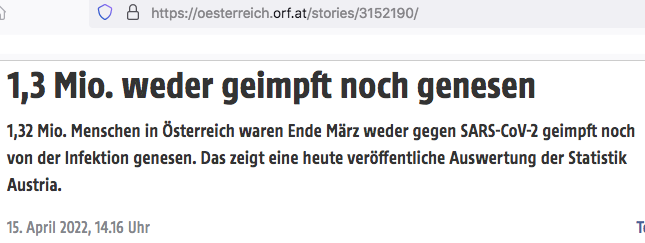
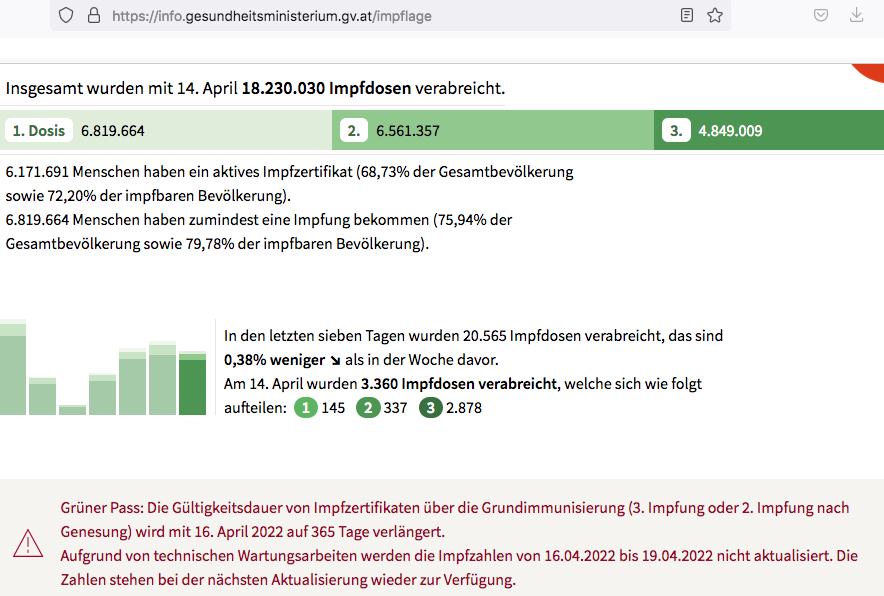
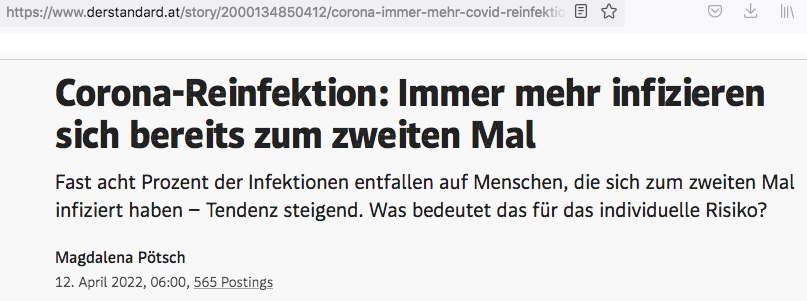
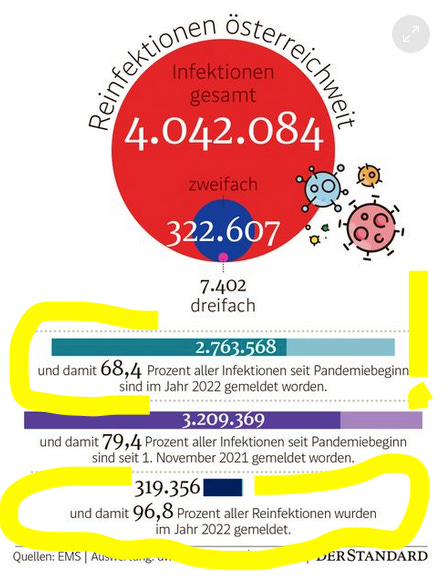
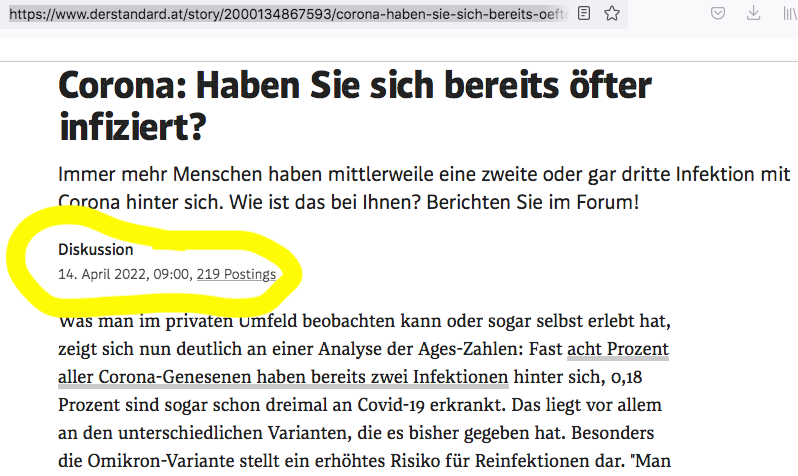


I got hung up on her statement of probability. It's completely useless. 1% risk of reinfection, does that mean in total for the rest of your life no matter exposure or does she mean as the risk upon coming into contact with the virus each and every time that occurs?
I too struggle with probability and probabilistics, but as a life long player of all kinds of games and a fan of game theory too, I know full well that 1% odds/chance/risk is not a small one, especially not over time. 1% is huge.
I'd like to ask her, what if the odds of getting punched in the nose every time she opens herfront door was 1/1 000 000, would that be a lot or a little? How about she has a risk of 1% every month that she doesn't get paid? What if we make it a cumulative risk, so for every time that 1% hits home, it increases; 1% becomes 2% becomes 3% and so on?
Like it seems to be for many who has had Covid and their shots and just keep getting Covid again and again, each time easier and more severe than the time before?
I'm thinking old man Hammurabi had the right of it when he stated that physicians who harm their patients be harmed in the same way...
There ought to be data gathered as to diet and lifestyles of those infected. Or maybe its easier to gather those not injected. Or both! These sterilized lifestyles people live makes them more vulnerable. I read an immunologist who claimed the best immune systems were always working. I also read studies proving farmers were healthier because they were exposed to all manner of different microbes. One more, those who live within 2 miles of where they were born had a higher chance of living long healthy lives - something about the local microbes protecting their positions in our bodies. So lets study these sterilized jet-setters first! Including you! Hahaha!
But we both know the injection is the real killer and anyone blaming all suffering on the virus in government releasing statistics are to be suspected of collaborating the fascist pharma-freak show dictates.